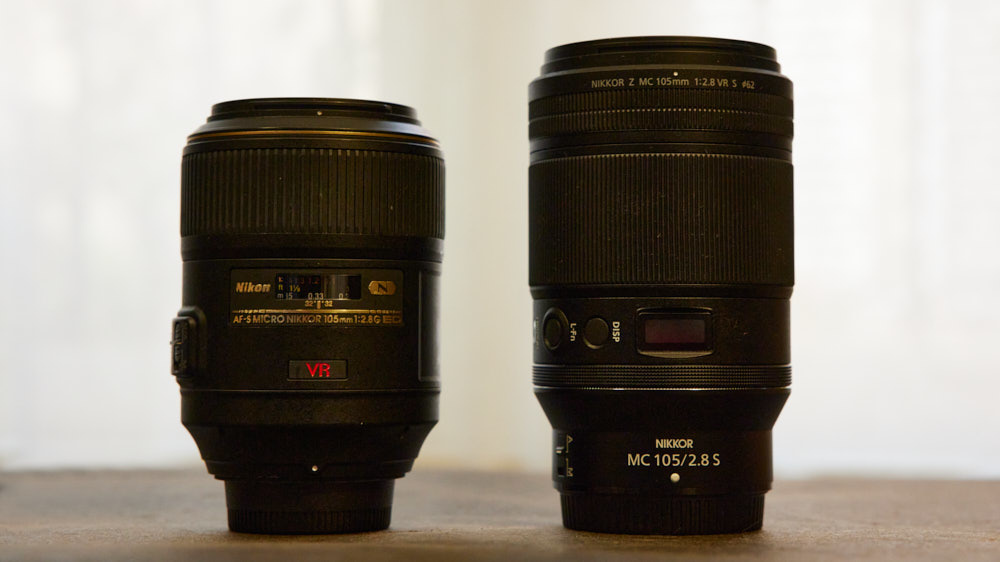This month, I’ve gotten a chance to spend some time shooting with one of Nikon’s two new macro lenses, the NIKKOR Z MC 105mm f/2.8 Macro.
Normally, I’m not someone who gets to use macro lenses a great deal. Not that I don’t love the look, but as someone whose subjects usually have two legs and move at the speed of a cheetah who is late for work, getting in super close to acquire minute detail is not always at the height of practicality. But as those two-legged cheetahs are usually wearing a particular garment from a particular brand that is paying this particular month’s mortgage, I am still often called upon to get in close to bring out the detail of textures and fabrics in the product being featured.
Outside of the professional arena, in more personal work, I find that macro lenses can open up a whole new world for me. It’s sort of like those Disney nature documentaries where they take cameras down to the way, way bottom of the sea and show you all those little creatures that look oddly and frighteningly like they might have been the inspiration for the killer alien you saw in that horror movie you watched last night and you think to yourself, “Wow, I had no idea that was even down there.” Macro lenses are a great way to get in close to a subject and reveal the tiniest details that often go missed by the naked eye. If only I had a dollar for every time in the last month that I’ve taken a detail shot with the macro lens only to see it pop up in Capture One with a stray hair or piece of lint in an unfortunate position. Then, I go to remove the obstruction and I can’t even find it with my eyes in the real world. Partly, this is because I am blind as a bat. Partly, this is because macro lenses have an ability to pull out detail you never thought imaginable.

Tower of DVDs shot by Nikon Z 7II with Z MC 105mm f/2.8 Macro
So far, Nikon’s macro lenses for it’s Z system come in two flavors: The 105mm f/2.8 and the 50mm f/2.8. Both have a 1:1 reproduction ratio and share the same maximum aperture. Both are very affordable with the 105mm coming in south of $1000 and the 50mm currently retailing just under $650. While I’ve heard the 105mm referred to as the more “standard” macro focal length, both lenses have their advantages. The main advantage of the 105mm is that it allows you to be further away from your subject. So, for instance, if you are photographing an especially skittish small creature, the extra length will allow you to avoid invading the creature’s personal space and risk scaring it away.

Personally, I’m not sure which of the two I would go for first. Because both lenses also give you the ability to do “normal” photography, meaning non-macro photography, as well as macro photography, potential buyers might want to take into account additional uses when making their decision. 50mm and 105mm just so happen to be my favorite focal lengths for standard primes. 50mm is my go-to for walkabout photography. But, as I wrote about in a recent article, the 105mm focal length is incredibly useful both as a walkaround lens as well as for portraits. Focal lengths are a matter of preference, but, for me, 105mm has come to hit something of a sweet spot.

As someone who owns an F mount version of the 105mm macro, the AF-S VR Micro NIKKOR 105mm f/2.8G IF-ED, I was curious to see how the new Z version would compare. The most obvious difference is the barrel length. The newer Z version is actually longer than the F version coming in at 5.5 inches versus 4.57 inches of the F mount version. But, despite the length difference, the newer version is actually lighter at 630 grams versus the 720 grams of the F mount. Mounted to the Z 7II versus the F version mounted to the D850, did form a lighter package although neither setup was particularly cumbersome.

In terms of image quality and sharpness, I give the new Z version the slight edge, although the same could be said for almost all the Z mount lenses I’ve had a chance to play with to this point. I still maintain that the lenses are the biggest reason to buy into the Z system and the new 105mm macro does nothing to dissuade that opinion.

Of course, I’m a big believer that advanced technology is only mildly important in the art of photography. Sure, it helps, but the real question with any piece of gear is whether or not it will help you realize your creative vision in a way that your current gear doesn’t. And while the increase in sharpness may or may not be something your audience can feel in the final result, the shorter minimum focusing distance of 11.4 inches versus the 1.03 feet of my F mount version is a practical advantage when trying to move in close.
Using the lens I was able to get extreme detail of objects from perspectives I might not normally consider.

And even though most discussion around lenses logically centers around sharpness, getting to play a bit with the super shallow depth of field of the 105mm macros allowed me to play a bit with abstraction as well to create some images far less literal.

So after spending some time with the lens, what did I like and what could be improved?
What I Liked
- Minimum focus distance has been improved.
- Beautiful bokeh.
- Tack sharp detail reveals hidden elements.
- It's very light. Physically speaking.
- The AF limiter helps to improve focusing performance.
- Price point.
What Could Be Improved
- I do wish it were shorter, although this is somewhat made up for with the lighter weight.
- Focus speed. It's not going to beat out your 70-200mm any time soon for focusing speed. Then again, it's not meant to.
The new 105mm for the Z system is a worthwhile successor to the F mount versions and seems to be a pretty fundamental piece of a photographer’s kit, especially if you focus on still life, food, or insect and plant life. At a very manageable weight, it’s a versatile lens that allows you to get closer to your subject with minimal fuss. If you’re someone who takes the time to look at the small details, it might just be the right lens for you.







It puzzles me that the Z lenses are so large. Was really under the impression that the whole point of mirrorless was a smaller footprint, but the Z class has totally blown that argument out of the water.
Exactly what I have been thinking and to think of it, with "The system’s large lens mount features a 55mm inner diameter and short 16mm flange focal distance which allow for flexibility in the optical design of NIKKOR Z lenses" shouldn't the lens be smaller and more compact. In comparison all Z lens are no different in size than F mount. Big disappointment that size and weight benefit are not in the equation anymore.
"all Z lens are no different in size than F mount"
Simply just not true.
Let me correct myself, its the case in most cases leaving aside the 24-70mm. Check the comparison on length and weight
Would be cool to add the 14-24 (and maybe 14-30) to the list. Wouldn't it? But maybe you are selective for a reason?
Also a quality column would be helpful. All the lenses - except the 70-200 - are eating their counterparts for lunch (I own them all and did compare).
"whole point of mirrorless was a smaller footprint"
Nikon never made that clam.
Agreed, but I didn't claim they did. Just an observation
You're right. And I'll take the quality of the Z glass anytime.
The actual advantage is to allow them to create lenses that provide better image quality with less optical compromise, and in that respect they are knocking it out of the park.
You don't really gain any size advantage with long lenses like a 105. Also, pop the FTZ adapter on the bottom of that F-mount lens and then show them side by side. Because that space does exist, it's just in the DSLR rather than the lens. When you do that, the Z mount version is smaller.
You'll never find a lens like the Nikon 14-30/4S coming in at that size and weight on any DSLR system. Or the 24-50. Or the 24-70/4 S.
There's also the issue that, yes, these lenses *could* be smaller. They'd also be optically worse if they were. So you can't really say "well this best-in-class lens here is bigger than its middling DSLR counterpart, so the whole wide flange thing is a joke."
Every lens designer balances quality, size, and cost every time they design a lens. Nikon is clearly aiming for quality above all else, while still keeping the cost around the same as competitor options. The 14-30 is a good example because it is not an optically perfect lens - it gives up edge and corner sharpness and distortion for super compact size and the ability to use a standard 82mm filter - the first 14mm FF lens that could do that from anyone. And yet it still has amazing image quality. THAT is where the wide throat of the mount shines.
Hmmm i would go with Laowa 100mm with 2x macro. And with a price tag of only $500
The Laowa is MF only....that is one reason it is cheaper
The Laowa is MF only ...one reason why it is cheaper